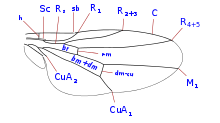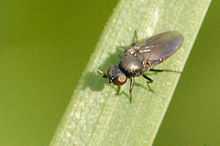Chloropidae
| Chloropidae | |
|---|---|
 | |
| Possibly Cetema cereris | |
| Scientific classification | |
| Kingdom: | Animalia |
| Phylum: | Arthropoda |
| Class: | Insecta |
| Order: | Diptera |
| Suborder: | Brachycera |
| Infraorder: | Muscomorpha |
| Section: | Schizophora |
| Subsection: | Acalyptratae |
| Superfamily: | Carnoidea |
| Family: | Chloropidae |
| Genera | |
| Diversity | |
| more than 160 genera | |
The Chloropidae are a family of flies commonly known as fruit flies or grass flies. About 2000 described species are in over 160 genera distributed worldwide. These are usually very small flies, yellow or black and appearing shiny due to the virtual absence of any hairs. The majority of the larvae are phytophagous, mainly on grasses, and can be major pests of cereals. However, parasitic and predatory species are known. A few species are kleptoparasites. Some species in the genera Hippelates and Siphunculina (S. funicola being quite well known in Asia) are called eye gnats or eye flies for their habit of being attracted to eyes. They feed on lachrymal secretions and other body fluids of various animals, including humans and are of medical significance.[1][2]
There are scant records of chloropids from amber deposits, mostly from the Eocene and Oligocene periods although some material may suggest the family dates back to the Cretaceous or earlier.
Family characteristics
For terms see Morphology of Diptera.
_mating.jpg)
Chloropidae are minute to small (l.0 to 4.0mm.), rarely medium-sized, flies (6.0 to 9.0 and 12 mm.)
They are either black, gray, yellow, or greenish and the mesonotum often has a pattern of three to five dark longitudinal stripes against a light-colored background. The head in profile is trapezoidal or triangular. Bristles on the head are weakly developed. Long orbital bristles on the head are present only in a few genera.The verrtical triangle is often large, (occupying almost all of the frons), and glossy, or matt (making it almost imperceptible). Arista for the most part thin with short sparse pubescence. Rarely the arista is densely pubescent in which case it appears thickened, or sometimes thickened and flattened. The proboscis is usually short and soft, only rarely with elongated sclerotized labella. The margin of the mouth is extended with elongation of proboscis and the vibrissal corner is raised beyond the margin of the eye.


The wings usually developed, only sometimes slightly shortened, rarely reduced to small disks (plates), with reduced venation. Sometimes femora 3 rarely femora 1 thickened; in the latter case the corresponding (1) tibia is usually curved.
The preabdomen in male consists of five segments: tergites 1 and tergite 2 are fused.Between tergite 5 of the abdomen and the hypopygium only one sclerite is present dorsally, with two close-set spiracles on each side.Sometimes this sclerite is reduced and rarely membranous swellings occur in this region, which are usually retracted and visible only in macerated specimens. In the subfamily Oscinellinae the hypopygium usually has well developed cerci and edites.The cerci in subfamily Chloropinae usually fused and for the most part reduced, and edites are reduced in size, pushed under the epandrium, and sometimes fused with it. The gonites are usually small, for most part membranous, and rarely highly sclerotized (Meromyza Mg.). For many species an examination of the genitalia of male, rarely of female, isessential for a precise species identification. See
Biology
Larvae are mainly phytophages of Gramineae, Cyperaceae, and Typhaceae; they develop inside the vegetative or reproductive parts, sometimes directly in the inflorescence or seeds. Some species cause the formation of unique cigar-shaped galls on stems Many species are known as serious pests of grain cereals. These include Oscinella frit L. and O. pusilla Mg., Chlorops pumilionis Bjerkander, Chlorops oryzae Matsumura an important pest of rice in eastern Asia and Meromyza saltatrix L., and M. nigriventris Mcq. The seeds of some grasses (bromes and wheat grasses) are damaged by flies of the genus Dicraeus Lw. Many larvae are also saprophages living on dying wood, usually in association with other insects, and in dead parts of herbaceous plants damaged by other insects. More rarely in they are found in fungi. In a small number of species the larvae are predators and live in the egg cocoons of spiders, praying mantis, or the nests of locusts. They sometimes prey on root grubs.
Flies are mainly caught in grass, rarely on trunks and branches of trees and shrubs, sometimes on flowering plants. Larvae usually hibernate and in some species the imagoes also hibernate .
Phylogenetics
| Carnoidea |
| ||||||||||||||||||||||||||||||
| |
Species Lists
- Fauna Europaea Palearctic
- Nearctic
- Japan
Literature
Identification
- Andersson, H., 1977 Taxonomic and phylogenetic studies on Chloropidae (Diptera) with species reference to Old World genear. Entom. Scand. Suppl. 8: 1-200 Keys most Old World genera.
- Becker, T., 1910 Chloropidae. Eine monographische Studie. Archivum Zoologicum Budapest 1:23-174 Keys genera and species of world fauna.
- Duda. 1933-1935. Chloropidae. In Lindner Die Fliegen der paläarktischen Region (the Flies of the Palaearctic Region).4, 68,1-278.
- E.P. Narchuk, E.S. Smirnov, L.I. Fedoseeva Family Chloropidae in Bei-Bienko, G. Ya, 1988 Keys to the insects of the European Part of the USSR Volume 5 (Diptera) Part 2 English edition
Gallery
-

Oscinella sp.
-
Meromyza sp. on Achillea millefolium (video, 1m 57s)
-
Chlorops sp. on Tanacetum vulgare (video, 51s)
See also:
External links
| Wikimedia Commons has media related to Chloropidae. |
| Wikispecies has information related to: Chloropidae |
- Pest Information Wiki
- Mass occurrences of Thaumatomyia notata (Narchuk)
- Encyclopedia of Life World checklist and images
Notes
- ↑ Robert Matheson (2008) Medical Entomology. Read Books. ISBN 1-4437-2540-4
- ↑ Uruyakorn Chansang, Mir S. Mulla (2008) Field Evaluation of Repellents and Insecticidal Aerosol Compositions for Repelling and Control of Siphunculina funicola (Diptera: Chloropidae) on Aggregation Sites in Thailand. Journal of the American Mosquito Control Association 24(2):299-307
References
- Chinery, Michael Collins Guide to the Insects of Britain and Western Europe 1986 (Reprinted 1991)
- Fossil Diptera catalog
| ||||||||||||||||||||||||||||||||||||||||||||||||||||||||||||||||||||||||||||||||||||||||||||||||||||||||||||||||||||||||||||||||||||||||||||||||||||||||||||||||||||||||||||||||||||||||||||||||||||||||||||||||||||



